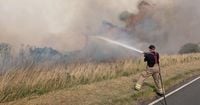Langdale Moor, nestled within the North York Moors National Park, has become the epicenter of a dramatic and dangerous battle against one of England’s largest wildfires in recent memory. Since August 11, 2025, emergency services have been locked in a round-the-clock struggle with a blaze that has consumed roughly 10 square miles (25 square kilometers) of moorland, threatening farms, businesses, and communities across North Yorkshire. Yet, as if the fire itself weren’t enough, an unexpected and explosive complication has hampered efforts: hidden World War Two bombs and tank shells, remnants from a 1940s-era tank training ground, have begun detonating as the flames burn deeper into the peat.
According to the BBC, North Yorkshire’s Chief Fire Officer Jonathan Dyson explained that the fire’s spread has been anything but predictable. “As the peat continues to burn down it is finding the World War Two ordnance and therefore exploding and we have now experienced over 18 ordnance explosions within key areas,” Dyson reported. The Ministry of Defence confirmed their explosive ordnance disposal team had responded to the Langdale Moor area on four separate occasions, discovering “various World War Two-era unexploded ordnance items,” which they described as “inert practice projectiles.” Nonetheless, the risk of further explosions forced fire crews to adopt what Dyson called a “very defensive fire-fighting strategy” in some sectors, prioritizing safety over direct intervention.
The situation escalated rapidly over the days leading up to August 27. A sudden change in wind direction and rising temperatures caused the fire to more than double in size within just 24 hours, pushing the flames further north and northwest. With 10 fire appliances and 60 firefighters committed to the operation, local resources were soon stretched thin. Mutual aid was requested, and up to 10 additional appliances from fire services across England were expected to arrive, according to BBC News and YorkshireLive. Dyson made it clear: “I have today made a request to National Resilience for national assets to be deployed to the area.”
On the ground, the response has been nothing short of a community-wide mobilization. Farmers, contractors, and gamekeepers have joined the fight, deploying heavy machinery to dig deep trenches and create firebreaks in an attempt to halt the fire’s advance. The North Yorkshire Moors Moorland Organisation posted on social media, “Heavy machinery has been deployed and is currently being used in great numbers to dig deep trenches to create fire breaks as shown in the video. The fire service with staff coming from far and wide are working with gamekeepers and farmers who are continuously cutting and wetting down areas on the frontline.” MP for Thirsk and Malton, Kevin Hollinrake, praised these efforts, commenting, “Incredible footage, the fire break is huge. But it’s leapt over (the trenches) once so right to take no chances. Great work by all involved.”
But even as the fire raged, a brief spell of heavy rain on August 27 brought a measure of relief. Residents in Hawsker and Whitby reported that the downpour helped clear away some of the smoke, and a rainbow arched over the landscape as the storm passed. “Hopefully the rain will end it soon,” one local remarked to YorkshireLive, echoing the hopes of many weary residents.
Despite this, the threat to local livelihoods and safety remained acute. Farmers and business owners found themselves on the front lines. At the Coast and Camplight glamping site in Stainsacre, Ed Gaskarth and Verity Bellamy began evacuating visitors as the fire approached. “I was born here. I’ve never known a summer like this before,” Gaskarth said. Bellamy added, “I’m really scared at the thought of the business going up in flames. I don’t know what we’d do. We haven’t slept and are praying for rain.”
Evacuations have been ordered in several small areas, including the village of Raw, where residents described the experience as “unbelievable.” Sophie Hinchliffe, who has lived in Raw for 36 years, told YorkshireLive, “It’s really upsetting seeing everything going up in flames. All the stuff that was burnt is where we were with dogs and horses a few days ago.” Meanwhile, holidaymakers like Jade Watson recounted the “overwhelming” and “surreal” experience of being evacuated with frightened children as the fire closed in on their campsite. “The speed and intensity of the situation were frightening and our kids were very scared seeing the smoke and flames so close,” Watson said.
Road closures have compounded the challenges. The A171, the main artery between Scarborough and Whitby, remains closed in both directions, with additional closures on the B1416 and Gowlands Lane in Cloughton. Karl Battersby, Corporate Director for Environment at North Yorkshire Council, explained, “We’ve also been putting in place a number of road closures to make sure that the public are safe and don’t get near to this incident, but primarily as well, to make sure the Fire Service can deal with the incident most effectively.”
Health concerns, too, have been front of mind. Plumes of acrid smoke have blanketed surrounding areas, irritating eyes and throats. Public Health Consultant Victoria Turner offered reassurance, stating, “Exposure to smoke from a large-scale wildfire, such as this, can cause some short term health issues - but little long term effects. There can be issues with skin and eyes and also coughing and wheezing. It is more likely to affect people with pre-existing lung conditions and heart conditions. People young and old are also at risk. The regular updates we are receiving from NHS/Ambulance services show there has not been an increase in health issues due to the fire.”
Amidst the chaos, the community’s resilience has shone through. Farmers have worked side by side with firefighters to slow the blaze, often risking their own safety. “It’s people’s livelihoods,” farm worker Darren Coates told BBC News. “To see the moors and farmland burned to a crisp it is just devastating.” Donations of food, water, and supplies have poured in for the emergency crews, with local businesses like Thorpe Stores in Fylingthorpe serving as collection points. “It shows that the community has come together, and it is just fantastic to see it when something like this happens,” said shop owner Dave Atkinson.
Political leaders have also stepped in. Conservative Party chairman Kevin Hollinrake called for national financial support, emphasizing that the burden should not fall solely on North Yorkshire taxpayers. Labour mayor David Skaith confirmed that financial aid had been secured and reassured the public, “We obviously understand that when we have fires and events like this, they come at a great cost, so having that support has been greatly received and we are working closer on our national level with the government to make sure that we have that ongoing support.”
Despite the devastation, the spirit of North Yorkshire remains unbroken. As Mayor Skaith put it, “The county is still open and we obviously still welcome people to York and Yorkshire, but bear the road closures and your safety in mind when you are planning to come.” For now, the fight continues—against flames, against history’s buried dangers, and for the communities that call the moors home.


